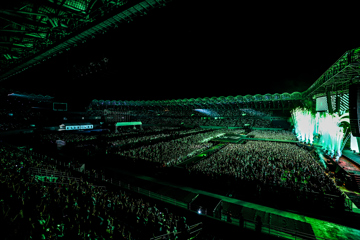Laurel Was Inspired To Make Her Film Clips By Old School Screen Tests
Laurel Arnell-Cullen – known monomyously as Laurel – tells Liz Giuffre about the beauty and intimacy in stillness.

Dogviolet is the debut album for UK singer/songwriter/producer Laurel Arnell-Cullen, known mononymously as Laurel. Fresh from SXSW, Arnell-Cullen speaks to The Music on an early morning London phone call, while on tour in the UK with KT Tunstall. Laurel’s work is minimalist but purposeful – there’s clear comparisons to be made with some of the best lady-led folk in the business, but there’s also an edge we’ve not heard before.
“You know, I really don’t mind comparisons that much, I think it’s really interesting to hear what people think,” Arnell-Cullen says. “This record has been compared to Florence & The Machine a lot, and I think she’s fucking incredible, and an amazing woman, so it’s always quite nice. I get Fleetwood Mac quite a lot at the moment which is a bit random, but I love Fleetwood Mac, so you know, it’s funny. It’s really interesting hearing what people say, because I can be like, ‘I never thought of that, but you think my record sounds like that.’”
"It’s so great and so interesting to hear everyone’s takes on it."
Laurel’s artistic aesthetic comes from a healthy mix of new and old approaches to making and presenting music. First sketching ideas in her bedroom on her laptop, she moves to record reel-to-reel, embracing the sound and experience that provides. “With [tape] you can only really get one take, and you can’t as easily copy and paste and save all of the takes, you really just have to wing it a bit more. But I think sometimes that’s what gives it the energy and excitement. It’s what you don’t get if you’ve just sat for hours on one thing.
“There’s a lot of times where you do a whole take and it’s great, except for this one little bit. And so actually re-recording that [one bit] means re-recording everything, so you accept it. And those imperfections are what makes music real rather than formulated. So keeping those [little imperfections] are what keeps is authentic.”
Also striking about Laurel’s debut are the videos for her singles Lovesick and Same Mistakes. Both are so still as to be almost completely static – an approach that at first confuses, but then draws the viewer and listener closer. At a time when artists are trying stunts like crazy dances and arresting costumes to get noticed, this understatement is a left turn, and quite the risk in lots of ways.
Don't miss a beat with our FREE daily newsletter
“I’d been watching all of these screen tests in American movies, before we had digital cameras. The night before they would shoot they would do all these tests – they’d roll the tape then send it to the lab just to check the cameras worked – and you can google these, they’re beautiful,” Arnell-Cullen begins. “A lot of the time, in these moments you caught people in their own natural environment, they were just so themselves, so from that we’ve developed a lot of the videos that we made for the album… I thought it might be nice to do something that wasn’t just a static image, but still wasn’t making a full video for it. [And] it’s great because they match the intimacy of the songs too.”
Is she concerned that being understated might mean being overlooked?
“It’s so funny, people can’t keep their attention on one thing for more than five seconds nowadays. I mean, sometimes you can try making something for that much money or not many resources, but it can end up being not as good. So we kind of just lived within the means of what we had, and I think that’s why these videos are very simplistic but I think they’re very beautiful as well.
“It happens at my gigs actually too – I’ve noticed the quieter you play the more people listen. And sometimes you can try and get people to listen by playing really loud when everyone’s talking, but what I’ve started doing is playing really quietly and people shut up. I wonder if there’s something in it. It wasn’t my intention [to make people lean in] – I just made what I felt like making. Which is why it’s so great and so interesting to hear everyone’s takes on it, because of course when you’re making it you don’t have any idea, really.”







